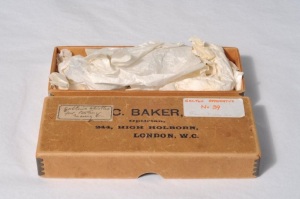RESPONSE #3 Kate Smith
How can historians uncover the ways in which historical actors used and experienced objects? In the most recent session of the 100 Hours project, Catherine Richardson (Reader in Renaissance Studies, School of English, University of Kent) challenged us to consider this question in light of Bruce Smith’s research on speech communities in early modern England. Central to Smith’s argument is the assertion that:
‘To understand how early modern speech communities functioned in everyday life, we need to situate them in their distinctive soundscapes. As the inhabitants of a certain geographical space, a speech community also constitutes an acoustic community. Its identity is maintained not only by what its members say in common but what they hear in common.’*
Smith’s assertion is important for shaping the ways in which we conceive of social practices more generally, and perhaps the use of material culture in particular. How we use objects is significantly determined by our experiences of witnessing others engage with them. Techniques of use are socially constructed and as such, often develop through engagements which are unrecorded. As in the case of apprenticeships, learning happens through watching and copying others. In consequence, as historian Pamela Smith argues, ‘experience is a different form of knowledge from discursive or propositional knowledge that can be written down and codified; thus it demands different methods of investigation and analysis’.** In her recent article ‘In the Workshop of History’, Smith worked with practising silversmith and conservator Tonny Beentjes to reconstruct the techniques contained in a sixteenth-century manuscript written by a French practitioner of metalworking. Their reconstruction involved a further side step, however, as the reconstruction ultimately aimed to gain a better understanding of the work of another contemporaneous master goldsmith, Wenzel Jamnitzer (1510-85).^ Reconstruction has long operated as a method of historical investigation, yet questions still remain as to what reconstruction actually reveals. For Smith it revealed new insights into technique, the final object and the nature of acquiring experiential knowledge. It also revealed the need to read recipes as a means of understanding, not necessarily how to do something, but rather the sort of attentions a practitioner should apply and to what.^^
As I mentioned in my last blog post, spending further time with the Galton whistle made me skeptical of it. Close looking left me at a loss to how it fitted together and worked. Central to understanding this particular object is developing an understanding of how people (Galton and perhaps others) used it. Despite pamphlets existing that describe the object and how it was used, it remains difficult to decipher how the different pieces fitted together and were operated as a whole. The next step of my research will be to look out to different texts that might reveal how the object should be constructed. Yet texts will not be the only important source here – other objects, other experts (with experience of using wind instruments for example) will be important in unpicking the tacit knowledge of use contained within the object.
* Bruce Smith, The Acoustic World of Early Modern England (U Chicago P, 1999), p. 46.
** Pamela H. Smith, ‘In the Workshop of History: Making, Writing, and Meaning’, West 86th, 19:1 (2012), p. 12.
^ Smith, ‘In the Workshop of History’, p. 16.
^^ Smith, ‘In the Workshop of History’, p. 25.


Really interesting points about tacit knowledge and practical understanding – recently was at the Vasa museum in Sweden where many of their conservators & historians come from ship-building/rope-making backgrounds. Discussions of multi-faceted tactile relationships (knowledge of weight, handling, touch & use etc.) with objects open a lot of doors I think, but also need to be careful of imagining that we can recreate the past through engaging in reconstructing the process of making and using.